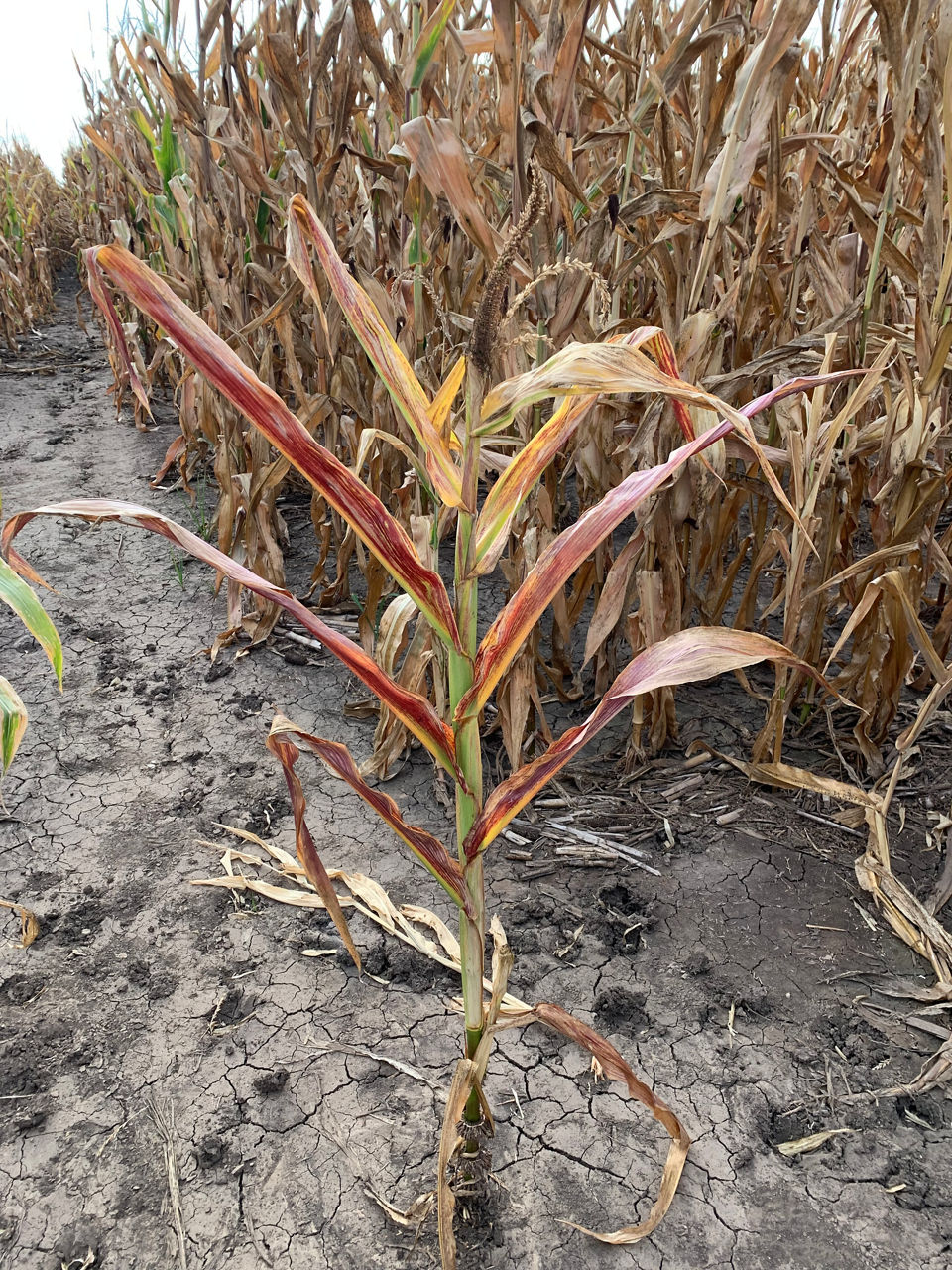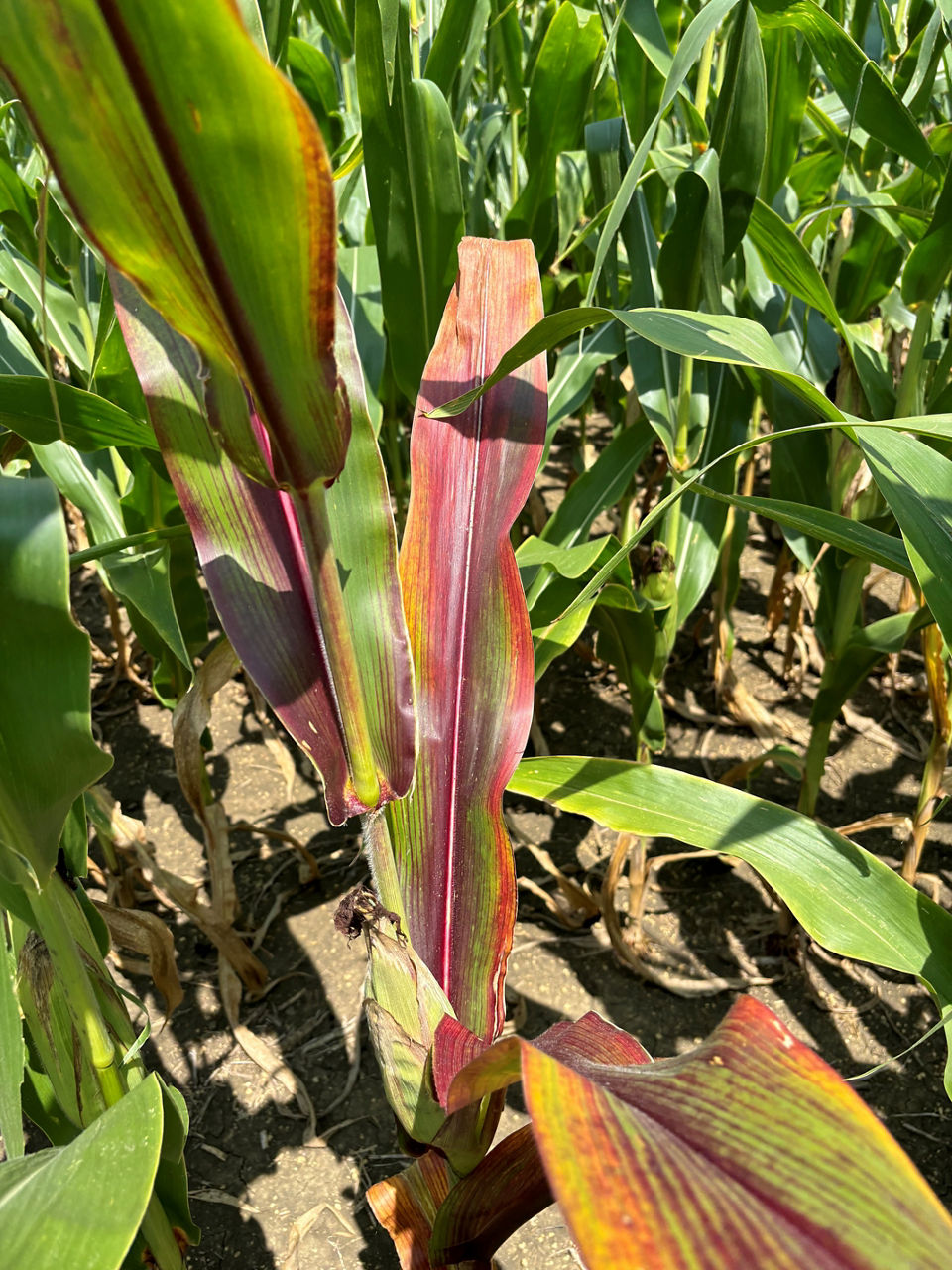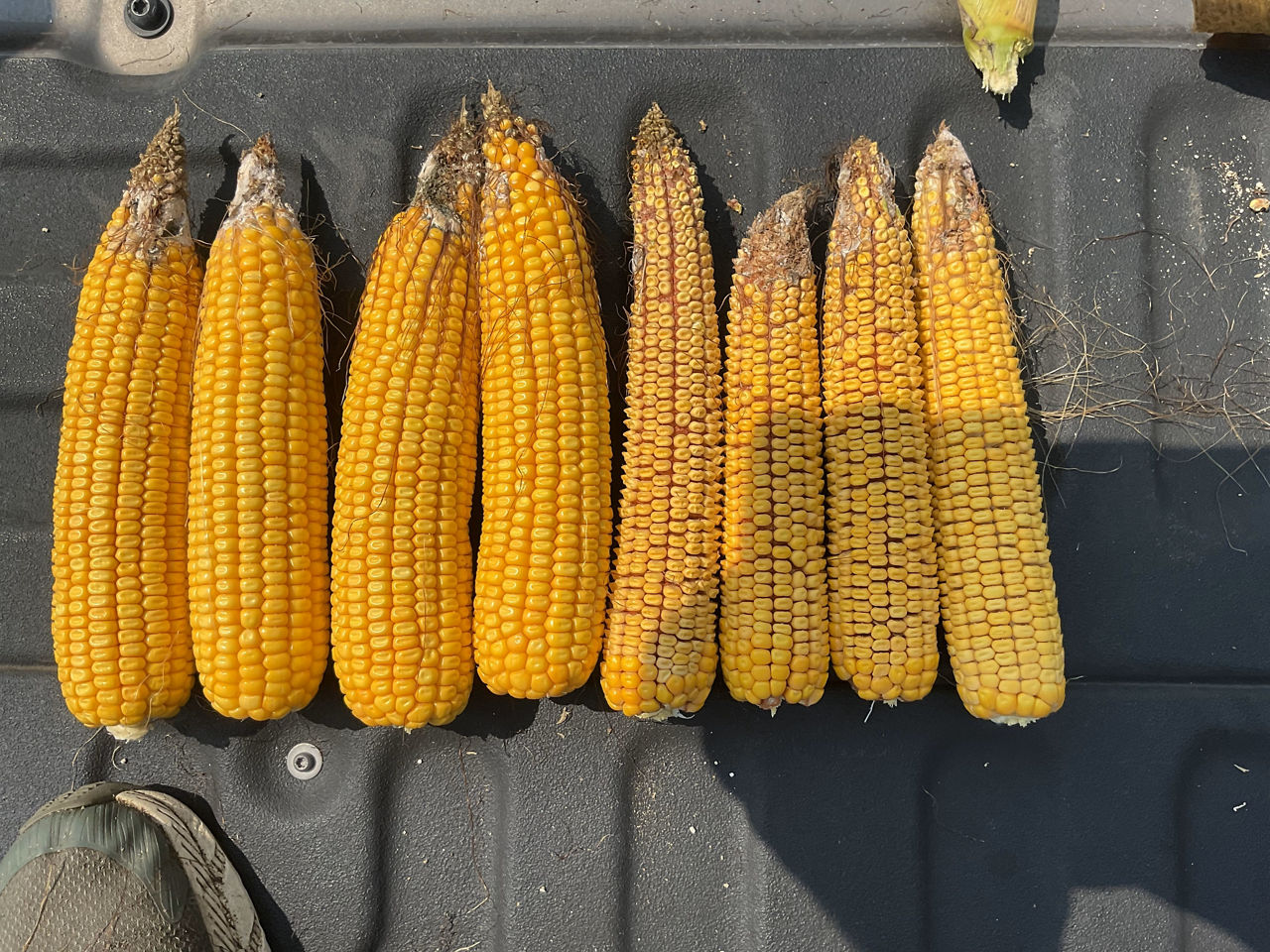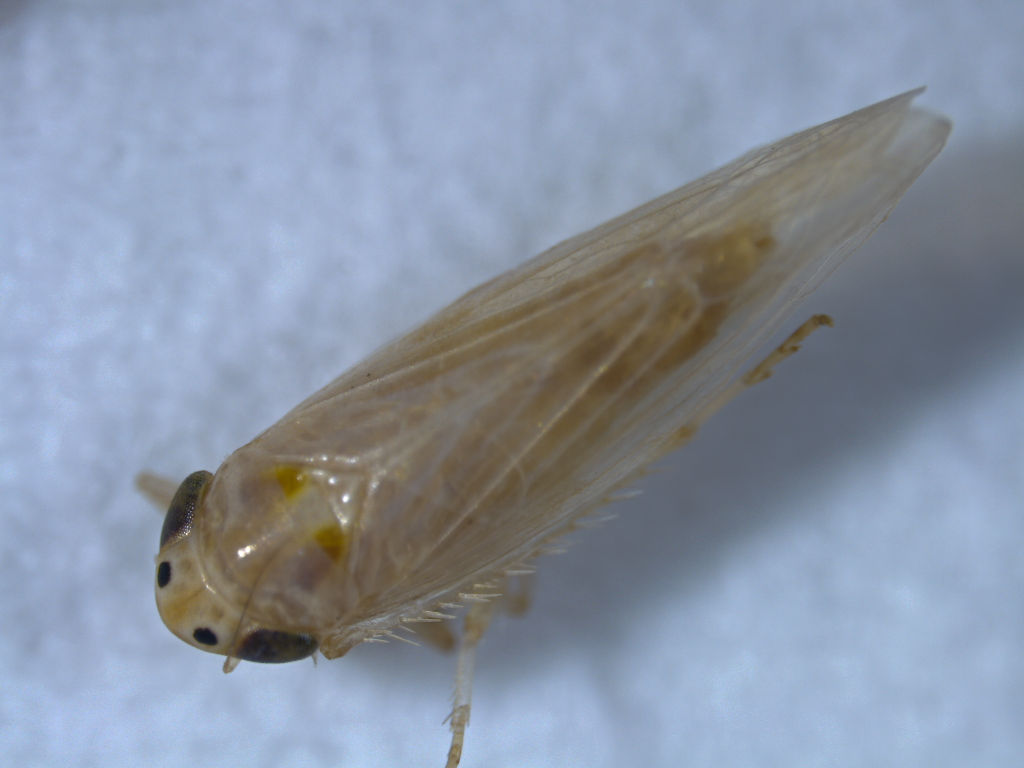Corn Stunt Spiroplasma Disease and Red Stunt Disease Complex
November 26, 2024
Corn stunt spiroplasma (CSS) disease (Figures 1 and 2) is caused by the bacterial pathogen Spiroplasma kunkelii and transmitted to corn plants by corn leafhoppers (Dalbulus maidis). CSS has been identified and observed in Florida, Texas, Oklahoma, Missouri, and California.1 It is not a new disease, but it is being observed more often. In 2024, CSS has been identified in Oklahoma and southwest Missouri while infections leading to definitive plant stunting have increased in Texas.2,3


Corn stunt has caused severe stunting and instances of 100% yield loss in Brazil and Argentina for many years because of the widespread presence of corn leafhoppers, which vector the disease.4 When corn leafhoppers colonized Florida in 1979 and 1980, the damage from CSS and direct leafhopper feeding caused a 98.5% decline in corn yield potential.4 The disease was sporadic in California prior to 1996, but since then it has occurred yearly with considerable yield losses.5 In Texas, the disease was first recorded in 1945, but it had little impact on yields.6
The University of Florida has also documented the transmission of maize rayado fino maya virus (MRFV) and the bacterial pathogen maize bushy stunt phytoplasma (MBSP) through corn leafhopper feeding.7 The three diseases may occur at the same time, though CSS is likely to be the dominant disease. An additional disease, maize striate mosaic virus (MSMV), has also been detected in corn in Brazil and Argentina and attributed to the presence of corn leafhoppers.8,9 Together, the four diseases have been referred to as the Red Stunt Disease Complex.
Disease Identification
The symptoms of CSS include stunting, short internodes, leaf streaking, multiple small ears, reddening of leaves, and poor kernel fill (Figures 1 thru 4). Developed kernels are loose on the ear and are referred to as “loose tooth ears” (Figure 4). Additionally, young leaves at the top of the plant are yellow and turn reddish to reddish purple as plants mature (Figures 1 and 2).2,5 Late planted corn is usually more susceptible to CSS; however, early planted corn can also be infected depending on the occurrence of corn leafhopper feeding.


Maize rayado fino maya (also called maize fine striping) virus symptoms include the development of small chlorotic spots at the base of the plant and along the veins of the youngest leaves.10 New leaves have more spots which can coalesce to form short stripes.10 The spots may collapse to form holes in the leaves of highly susceptible plants. Wilting and plant death can occur. The root system can be restricted, and ears may have few or no kernels.10
Maize bushy stunt phytoplasma (MBSP) symptoms mimic CSS. Initial symptoms are chlorosis of whorl leaf margins while older leaves become reddish. Emerging leaves become increasingly chlorotic, and the leaf margins become tattered or torn.11 Older leaves become redder and internode length is reduced, causing the stunted appearance. The appearance of axillary and basil shoots gives the plant a bushy appearance. Tassels and ears are not formed or are barren.11 Multiple ears may develop without grain. Disease severity is more severe with high temperatures. Seedling stage infection is more severe than late season infection.11 In the field, it is not possible to differentiate the causal agent of stunt disease based solely on plant symptoms due to the similarity of symptoms between diseases and due to the simultaneous infection of plants by CSS, MBSP, and streak virus. In addition, the manifestation of symptoms is influenced by the genetic makeup of the infected plants, their capacity to produce anthocyanins (pigments associated with sugar that give purple to reddish coloration), and environmental conditions. Because of these factors, although reddening of the leaves is a common characteristic of plants affected by stunt disease, some plants only present chlorosis on the margins and tips of leaves. Therefore, laboratory analysis is essential for identification of stunt diseases.
Maize striate mosaic virus symptoms include dwarfism, plant deformation, interveinal yellowing, chlorotic rings, chlorosis along leaf edges, and vein thickening.8,9
Management
Management of the corn stunt complex should involve multiple practices which together aim to reduce the source of disease inoculum and the population of corn leafhoppers. Thresholds for treatment have not been determined and in most cases are not recommended due to the high efficiency of this insect as a pathogen vector. Attempting to chemically control corn leafhoppers is both very difficult and risky, because leafhoppers lay many eggs below the epidermis of the corn plant and because adults and juveniles can quickly move around and between plants. Systemic seed treatments have reduced corn leafhopper populations, but these treatments have only negligibly reduced the occurrence of CSS.4 Additionally, since the diseases vectored by corn leafhoppers are not fungal, fungicides are not effective for their control. However, fungicidal treatments may help with the management of other fungal diseases that are expected or present. A management strategy that uses chemical control in addition to working with other growers in the region to synchronize planting over 20 to 30 days, interrupting the “green bridge” between corn crops, eliminating volunteer corn plants in the off-season, and planting disease tolerant corn products can help in the efficient management of this disease complex.12 (The term “green bridge” refers to any weed, cover crop, or volunteer plant that allows pathogens or pests to survive between the harvest of one crop and emergence of another crop.13)
Scouting and awareness are the best recommendations for management, and management strategies should be based on observations of the possible sources of virus inoculum in fields in the region. However, while the absence of fields with stunt symptoms in the region reduces the risk of disease occurrence, it does not guarantee its absence. Corn leafhoppers vectoring the disease complex can migrate long distances, often by traveling on wind currents, in search of favorable environmentals.14 Regionally synchronized corn planting helps prevent the migration of leafhoppers from fields in the reproductive phase to fields in early stages of development. Migration increases the risk of damage in fields with late planting, since the disease can be transmitted early in the cycle and doing so results in a greater impact on productivity.12,15,16 Interrupting the green bridge—that is, interrupting corn and other cereal cultivation during a period of the year—helps manage corn stunt by removing the host plants required by corn leafhoppers, its insect vectors, particularly by removing potential host plants of the genus Zea. As such, eliminating volunteer corn plants is particularly important to managing corn stunt.17,18
If corn leafhopper populations are high enough to cause leaf death, labeled insecticides can reduce the direct feeding; however, disease transmission will likely have already occurred. Disease symptoms do not appear until about 30 days after transmission; therefore, mid-to-late season transmissions are likely too late to have a large effect on yield potential and planting early may allow plants to be more mature before the pathogens are transmitted by feeding leafhoppers.6,12
Corn Leafhopper
The corn leafhopper is one species of many in the Cicadellidae family. Distinguishing characteristics of the corn leafhopper are the two black spots between their eyes and pale yellow to greenish yellow coloration (Figures 5 and 6).7


Most leafhoppers are small (1/8 to ¼ inch long), narrow, have wedge-shaped bodies, bulging eyes, and are usually green to brown.19 They are found worldwide on agricultural crops, vegetables, flowers, and other plants. They jump vigorously when approached as they sit on leaves. Their lifecycle consists of egg, nymph, and adult. The nymphs resemble adults but are wingless.
Leafhopper injury to corn can come directly from feeding or indirectly through disease transmission, such as reduced photosynthesis from sooty mold on leaves. Heavy infestations of corn leafhoppers can cause premature leaf desiccation by sucking plant juices out of leaves, causing several leaves or individual leaves to turn brown. While feeding, they also secrete a sticky substance (honeydew) that is favorable for mold growth. The black sooty mold encouraged by honeydew can reduce a leaf’s ability to photosynthesize, limiting the production of sugars and carbohydrates necessary for grain fill and resulting in lost yield potential. Note that the corn leaf aphid also produces honeydew; therefore, it is important to identify which pest is causing the symptom for the selection of an appropriate management strategy.1
Sources
1Godfrey, L.D., Wright, S.D., Summers, C.G., Frate, C.A., and Jimenez, M.J. 2006. Corn leafhopper. Dalbulus maidis. Agriculture: corn pest management guidelines. University of California ANR Publication 3443. https://ipm.ucanr.edu/agriculture/corn/corn-leafhopper/#gsc.tab=0
2Faris, A.M. and Duffeck, M. 2024. Corn leafhopper leads to corn stunt disease across Oklahoma – August 12, 2024. (EPP-23-17). OSU Extension. Oklahoma State University. https://extension.okstate.edu/e-pest-alerts/2024/corn-leafhopper-leads-to-corn-stunt-outbreak-across-oklahoma-aug-12-2024.html
3Geist, L. 2024. First case of corn stunt confirmed in Missouri. University of Missouri Extension. https://extension.missouri.edu/news/first-case-of-corn-stunt-confirmed-in-missouri
4Jones, T.L. and Medina, R.F. 2020. Corn stunt disease: An ideal insect-microbial-plant pathosystem for comprehensive studies of vector-borne plant diseases of corn. Plants. 9(6): 747. https://doi.org/10.3390/plants9060747
5Davis, R.M. 2006. Corn stunt (Spiroplasma kunkelii). University of California, IPM Pest Management Guidelines: Corn. ANR Publication 3443. https://ipm.ucanr.edu/agriculture/corn/corn-stunt/#gsc.tab=0
6Biles, S. 2024. Leafhoppers in corn: Update. Texas A&M AgriLife Extension, Mid-Coast IPM. https://agrilife.org/mid-coast-ipm/leafhoppers-in-corn-update/
7Corn leafhopper: Dalbulus maidis, Cicadellidae. University of Florida, Florida Corn Insect Identification Guide. https://erec.ifas.ufl.edu/fciig/frleadm.htm
8Fontenele, R.S., Alves-Freitas, D.M.T., Silva, P.I.T., et al. 2018. Discovery of the first maize-infecting mastrevirus in the Americas using a vector-enabled metagenomics approach. Archives of Virology. 163: 263–267. https://doi.org/10.1007/s00705-017-3571-2
9Posse, A.R., Fernandez, F., Reyna, P., Nome, C., Torrico, A. K., Pecci, M.P.G., Pardina, P.R., 2023. First report of maize striate mosaic virus, a mastrevirus infecting Zea mays in Argentina. New Disease Reports. 47(2): e12186. https://doi.org/10.1002/ndr2.12186
102021. Maize rayado fino virus (maize rayado fino). CABI Digital Library. https://www.cabidigitallibrary.org/doi/10.1079/cabicompendium.32516
112019. Maize bushy stunt phytoplasma (maize bushy stunt). CABI Digital Library. https://www.cabidigitallibrary.org/doi/10.1079/cabicompendium.31990
12Sabato, E.de O. 2018. Manejo do risco de enfezamentos e da cigarrinha no milho. Embrapa Milho e Sorgo. Comunicado Técnico, 226. https://ainfo.cnptia.embrapa.br/digital/bitstream/item/177361/1/ct-226.pdf
13Lessiter, F. 2014. “Spray and Wait” is critical to tackling green bridge pathogens. No-Till Farmer. https://www.no-tillfarmer.com/articles/487-spray-and-wait-is-critical-to-tackling-green-bridge-pathogens?v=preview
14Oliveira, C.M., Molina, R.M.S., Albres, R.S., and Lopes, J.R.S. 2002. Disseminação de molicutes do milho a longas distâncias por Dalbulus maidis (Hemiptera: Cicadellidae). Fitopatologia Brasileira. 27(1): 91–95. https://doi.org/10.1590/S0100-41582002000100015
15Oliveira, E., Ternes, S., Vilamiu, R., Landau, E.C., and Martins, C.O. 2015. Abundance of the insect vector of two diferente Mollicutes plant pathogens in the vegetative maize cycle. Phytopathogenic Mollicutes. 5(S-1): S117–S118. http://dx.doi.org/10.5958/2249-4677.2015.00050.X
16Todd, J.L., Madden, L.V., and Nault, L.R. 1991. Comparative growth and spatial distribution of Dalbulus leafhopper populations (Homoptera: Cicadellidae) in relation to maize phenology. Environmental Entomology. 20(2): 556–564. https://doi.org/10.1093/ee/20.2.556
17Oliveira, C.M., Lopes, J.R.S., Nault, L.R. 2013. Survival strategies of Dalbulus maidis during maize off-season in Brazil. Entomologia Evironmentalis et Applicata. 147(2): 141–153. https://doi.org/10.1111/eea.12059
18Summers, C.G., Newton, Jr., A.S., Opgenorth, D.C. 2004. Overwintering of corn leafhopper, Dalbulus maidis (Homoptera: Cicadellidae), and Spiroplasma kunkelli (Mycoplasmatales: Spiroplasmataceae) in California’s San Joaquin Valley. Environmental Entomology. 33(6): 1644–1651. https://academic.oup.com/ee/article/33/6/1644/353636
19How to get rid of leafhoppers in the garden. Gardenia, Leafhopper. https://www.gardenia.net/pest/leafhoppers
Additional Resource
Kerns, D., Führ, F.M., Biles, S., Sekula, D., Santiago-González, J.C., Wilson, G., Mays, T., Drake, D., Isakeit, T., and Alavi, O. 2024. Corn leafhopper and the red stunt disease complex. Texas A&M AgriLife Extension. ENTO-PU-229. https://southtexas.tamu.edu/files/2024/10/ENTO-PU-229-Corn-Leafhopper-and-the-Red-Stunt-Disease-Complex.pdf
Web sources verified 10/18/24. 1211_448301
Seed Brands & Traits
Crop Protection
Disclaimer
Always read and follow pesticide label directions, insect resistance management requirements (where applicable), and grain marketing and all other stewardship practices.
©2024 Bayer Group. All rights reserved.